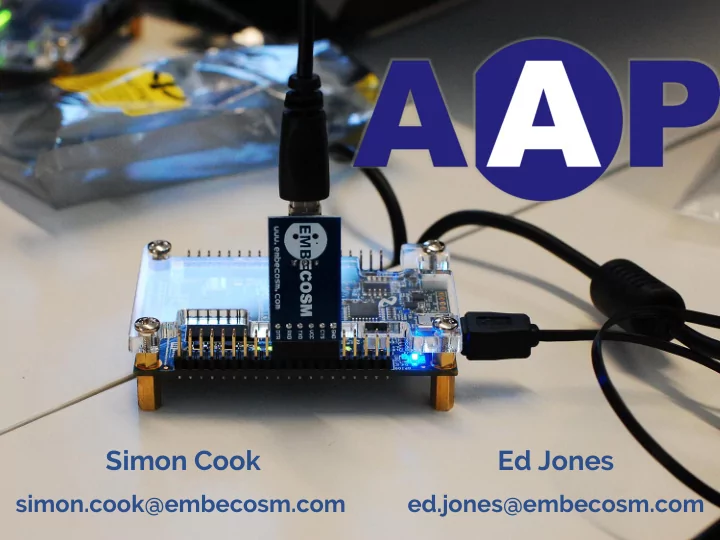

Simon Cook Ed Jones simon.cook@embecosm.com ed.jones@embecosm.com
Current in-tree architectures Arch Server Desktop Embedded MCU DSP GPU Hardware Reg size ✓ ✓ ✓ ✓ AArch64 64 ✓ AMDGPU 32 ✓ ✓ ✓ ✓ ARM 32 BPF 64 ✓ Hexagon 32 Lanai ? ? 32 ✓ ✓ Mips 32, 64 ✓ ✓ ✓ MSP430 16 ✓ NVPTX 16, 32, 64 ✓ ✓ ✓ ✓ PowerPC 32, 64 ✓ ✓ ✓ ✓ Sparc 64 ✓ ✓ SystemZ 32, 64 WebAsm 32, 64 ✓ ✓ ✓ ✓ X86 16, 32, 64 ✓ ✓ XCore 32 ✓ ✓ ✓ AVR 8 ✓ ✓ ✓ ✓ RISC-V 32
Out-of-tree Architectures • MCUs, DSPs • 8/16/24/40 bit registers, >8 bit bytes • Novel addressing modes • Complex register constraints • Size > performance • Can't always upstream Exposes confidential hardware details Only internal use Lots of generic changes
AAP Arch Server Desktop Embedded MCU DSP GPU Hardware Register size ✓ ✓ ✓ ✓ AAP 16 • Community driven, incrementally update architecture to solve community needs • Aim to be in-tree to avoid bit-rot • Smooth the path for other back-ends to come in-tree • RISC with MCU and DSP features
AAP Design
AAP Design AAP exists to improve LLVM. Some areas we’re looking at: • Non-octet chars • Non-power of 2 registers • Multiple function pointer sizes • Finer-grained control over legalization • Stack cheaper than registers
Non-octet Chars Very common in DSPs, but 8-bit chars are hardcoded in a few places in LLVM/Clang • getPointerSizeInBits getTypeStoreSize / getTypeStoreSizeInBits • …. • Has appeared a couple of times in the mailing list (including /w patches). But patches never made it in.
Non-power of 2 registers Also very common in DSPs. Generic LLVM only has power-of-2 in the MVT. Support for common DSP register sizes would be nice (i24) Again, patches have appeared on the mailing list. Understandably, with no in-tree targets the patches weren't included.
Multiple function pointer sizes Some architectures have code which lives in different address spaces. Function pointers may be different sizes And different size pointers may point to the same function • Call and return instructions used may differ depending on pointer type Can expand meaning of address_space in LLVM to work for functions.
Finer-grained legalization control • Some architectures have multiple register sizes • May only be able to do a subset of operations on the larger register • But if the larger register is legal, then LLVM will use it liberally. • Can occur if your address registers are larger than your data registers.
Stack cheaper than registers • Some architectures can perform operations on the stack directly. • May be cheaper than registers: For a subset of stack locations For a subset of operations • Want to sometimes treat stack slots like registers. load r0, sp+2 add r0, r1 add sp+2, r1 store sp+2, r0
Stack cheaper than registers • Cost of spilling a register varies Free if subsequent uses of the value can operate directly on the stack • Stack slot allocation varies Allocate cheap stack slots to minimize number of loads into registers • Instruction selection varies Choose instructions to prefer operations which can use the stack
Differential Patches D23665 – ELF Definitions D23666 – Backend Stub D23667 – Tablegen D23771 – MC D23772 – AsmParser D23773 – InstPrinter
embecosm.com
Recommend
More recommend